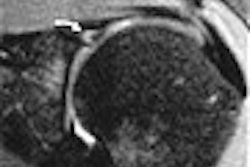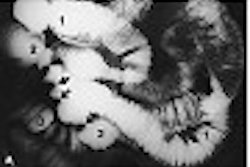(Radiology Review) Radiologists at the University Hospitals in Basel, Switzerland believe they have determined the optimum dose for dynamic, time-resolved, contrast-enhanced 3-D MR angiography (MRA) of pulmonary circulation.
"We sought to determine the best contrast media dose for dynamic contrast-enhanced 3-D MR angiography of the pulmonary circulation with respect to depiction of pulmonary artery branches; depiction of pulmonary parenchyma, which can reflect pulmonary perfusion; and differentiation of pulmonary arteries from veins," wrote Dr. Stefan Sonnet and colleagues.
A prospective study was performed using 20 volunteers (ages20-38). Imaging was performed on a 1.5-tesla scanner with Quantum gradients and a four-element phased-array body coil.
"Slabs for contrast-enhanced 3-D MR angiography were oriented in the coronal direction and acquired using a turbo fast low-angle shot sequence (TR/TE, 2.4/1.04; flip angle, 20°; slice thickness, 5 mm; minimal field of view, 400 x 400 mm; matrix, 120 x 256. Ten consecutive 3-D slices were prescribed with an acquisition time of 3.2 sec each; thus, the total imaging time for contrast-enhanced 3-D MR angiography was 32 sec," they reported.
The 20 volunteers were divided into four groups. Using a pressure injector, gadoterate meglumine was injected at doses of 0.025, 0.05, 0.1, or 0.2 mmol/kg, followed by a saline flush of 30 ml at a flow rate of 4 ml/sec. Contrast was administered through a large-gauge cannula inserted into an antecubital vein. Image quality was assessed for the four of contrast dosages and an image quality score was assigned according to the visibility of pulmonary vessels and parenchyma.
Results showed that both pulmonary arteries were well demonstrated in all subjects. "(Signal intensity, SI) measurements in the pulmonary trunk showed strong SI at all tested doses," they reported.
The lobar, pulmonary and segmental arteries were best visualized using 0.1 mmol/kg. Poor delineation of the subsegmental arteries was shown using all four dosages.
"Pulmonary parenchyma was visible but blurry with 0.1 and 0.2 mmol/kg of gadoterate meglumine. Thus dynamic time-resolved contrast-enhanced 3D MR angiography may be useful for qualitative assessment of pulmonary perfusion but not for depiction of anatomic details of the lungs," the authors maintained.
"Dynamic time-resolved contrast enhanced 3D MR angiography is easy to apply because it requires no bolus-timing scan and it can be readily implemented on most clinical scanners," they concluded. "For assessment of pulmonary vessels, a dose of 0.1 mmol/kg of gadolinium chelates can be recommended." This dosage enables good visualization of pulmonary arteries and qualitative assessment of pulmonary parenchyma, according to the authors.
Dose optimization for dynamic time-resolved contrast-enhanced 3D MR angiography of pulmonary circulationStefan Sonnet, et. al.
Department of radiology, University Hospitals Basel, Basel, Switzerland
AJR 2003 December; 181:1499-1503
By Radiology Review
January 28, 2004
Copyright © 2004 AuntMinnie.com



.fFmgij6Hin.png?auto=compress%2Cformat&fit=crop&h=100&q=70&w=100)




.fFmgij6Hin.png?auto=compress%2Cformat&fit=crop&h=167&q=70&w=250)











